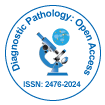CDKN2B-AS1 ceRNA Network and KRAS-Dependent Tumorigenicity in Colorectal and Pancreatic Cancer
Received Date: Oct 30, 2024 / Published Date: Dec 02, 2024
Abstract
Abstract Objective: Kirsten Rat Sarcoma Viral Oncogene Homolog (KRAS) exhibits the highest mutation rate in Colorectal Cancer (CRC) and Pancreatic Cancer (PC), highlighting the need for a comprehensive understanding of KRAS-dependent pathogenesis. Given the regulatory role of long noncoding RNAs (lncRNAs) in gene expression, this study focused on constructing a competing endogenous RNA (ceRNA) network of a selected KRAS-related lncRNA. Methods: Differentially Expressed Genes (DEGs) were identified using sequencing data from the sequencing read archive database by analyzing the transcriptional profiles of CRC and PC cell lines with and without KRAS mutations. LncTarD, miRWalk and ToppCluster servers were used to construct ceRNA network of selected lncRNA to elucidate the interactions between corresponding miRNAs and target genes. Results: Notably, the analysis revealed 42 common upregulated DEGs (uDEGs), including differentially expressed lncRNAs and protein-coding genes, between KRAS-mutant and KRAS wild-type cells. Among them, CDKN2B-AS1 emerged as a key KRAS-related lncRNA for constructing the ceRNA network. The ceRNA network of CDKN2B-AS1 included 21 miRNAs and 34 genes selected from common uDEGs. Enrichment analysis of ceRNA target genes validated their involvement in critical cancer-related pathways and biological processes. Important, expression and survival analysis underscored the prognostic significance of some target genes within the CDKN2B-AS1 ceRNA network. Conclusions: Consistent with the key regulatory role of lncRNAs, the identification of CDKN2B-AS1 as a KRAS-related lncRNA and the construction of its ceRNA network improve our understanding of the potential contribution of lncRNAs to KRAS-associated pathogenesis and their application as potential diagnostic and prognostic biomarkers for KRAS-mutant cancers.
Keywords: KRAS mutation; CDKN2B-AS1; Colorectal cancer; Pancreatic cancer; ceRNA network; Long noncoding RNAs; Differential expression analysis
Citation: Saliani M, Ahmadian MR, Gonbadi P, Dastgir F, Daryasary HM, et al. (2024) CDKN2B-AS1 ceRNA Network and KRAS-Dependent Tumorigenicity in Colorectal and Pancreatic Cancer. Diagn Pathol Open 9:242.
Copyright: © 2024 Saliani M, et al. This is an open-access article distributed under the terms of the Creative Commons Attribution License, which permits unrestricted use, distribution, and reproduction in any medium, provided the original author and source are credited.
Share This Article
Open Access Journals
Article Usage
- Total views: 205
- [From(publication date): 0-0 - Apr 18, 2025]
- Breakdown by view type
- HTML page views: 56
- PDF downloads: 149
